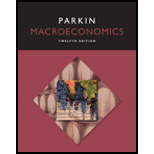
Macroeconomics (12th Edition) (Pearson Series in Economics)
12th Edition
ISBN: 9780133872644
Author: Michael Parkin
Publisher: PEARSON
expand_more
expand_more
format_list_bulleted
Question
Chapter 1.1, Problem 2RQ
To determine
Examples of scarcity.
Expert Solution & Answer
Trending nowThis is a popular solution!

Students have asked these similar questions
I need typing clear urjent no chatgpt used i will give 5 upvotes pls full explain
Not use ai please
Consider that the macroeconomy is hit by aftershocks. Exports decrease by $40 billion and imports increase by $200 billion. Modify your macroeconomic model to reflect both these aftershocks. At GDP of 8200
Chapter 1 Solutions
Macroeconomics (12th Edition) (Pearson Series in Economics)
Ch. 1.1 - Prob. 1RQCh. 1.1 - Prob. 2RQCh. 1.1 - Prob. 3RQCh. 1.2 - Prob. 1RQCh. 1.2 - Prob. 2RQCh. 1.3 - Prob. 1RQCh. 1.3 - Prob. 2RQCh. 1.3 - Prob. 3RQCh. 1.3 - Prob. 4RQCh. 1.3 - Prob. 5RQ
Ch. 1.4 - Prob. 1RQCh. 1.4 - Prob. 2RQCh. 1.4 - Prob. 3RQCh. 1.4 - Prob. 4RQCh. 1.A - Prob. 1RQCh. 1.A - Prob. 2RQCh. 1.A - Prob. 3RQCh. 1.A - Prob. 4RQCh. 1.A - Prob. 5RQCh. 1.A - Prob. 6RQCh. 1.A - Prob. 7RQCh. 1.A - Prob. 8RQCh. 1.A - Prob. 9RQCh. 1.A - Prob. 10RQCh. 1.A - Prob. 11RQCh. 1.A - Prob. 1SPACh. 1.A - Prob. 2SPACh. 1.A - Prob. 3SPACh. 1.A - Prob. 4SPACh. 1.A - Prob. 5SPACh. 1.A - Prob. 6SPACh. 1.A - Prob. 7SPACh. 1.A - Prob. 8SPACh. 1.A - Prob. 9SPACh. 1.A - Prob. 10SPACh. 1.A - Prob. 11SPACh. 1.A - Prob. 12APACh. 1.A - Prob. 13APACh. 1.A - Prob. 14APACh. 1.A - Prob. 15APACh. 1.A - Prob. 16APACh. 1.A - Prob. 17APACh. 1.A - Prob. 18APACh. 1.A - Prob. 19APACh. 1.A - Prob. 20APACh. 1.A - Prob. 21APACh. 1.A - Prob. 22APACh. 1.A - Prob. 23APACh. 1 - Prob. 1SPACh. 1 - Prob. 2SPACh. 1 - Prob. 3SPACh. 1 - Prob. 4SPACh. 1 - Prob. 5SPACh. 1 - Prob. 6SPACh. 1 - Prob. 7APACh. 1 - Prob. 8APACh. 1 - Prob. 9APACh. 1 - Prob. 10APACh. 1 - Prob. 11APACh. 1 - Prob. 12APACh. 1 - Prob. 13APA
Knowledge Booster
Similar questions
- Please don't use Ai solution Phoebe's pintxos is a restaurant seeking a loan from a well capitalized bank. In order to achieve this, they should seek banks who have a leverage ratio of: a) 2.1% b) 5.3% c) 3.3%arrow_forwardNot use ai pleasearrow_forwardDon't give AI generated solution otherwise I will give you downwardarrow_forward
- Consider the following Bertrand Duopoly game between Firm A and Firm B. Firm B Bertrand Duopoly Low Price High Price Low Price 0,0 5,-1 Firm A High Price -1,5 3,3 a. Is there a dominant strategy equilibrium for a one-shot, simultaneous-move game? If so, what is it? If not, explain why. (2 points) b. Identify any and all Nash equilibria for a one-shot, simultaneous-move game. (1 point) c. What is Firm A's secure strategy for a one-shot, simultaneous-move game? What is Firm B's secure strategy for a one-shot, simultaneous-move game? (2 points) d. Assume that Firm A and Firm B agree to collude and both charge high prices as long as neither of them cheats by charging low prices. If one of the firms cheats, trigger strategies take hold whereby the "victim" punishes the "cheater" by charging low prices forever after. If this game is infinitely repeated, calculate the interest rate (i) necessary to sustain collusion. (3 points) e. Assume that Firm A and Firm B agree to collude and both charge…arrow_forwardDon't used Ai solutionarrow_forwardThere is Village A where the luxury axiom and the substitution axiom are satisfied (as discussed in Chapter 6). In this village, 200 households and 100 firms exist. Each household is composed of 4 household members: two adults and two children. One of the children is a teenage daughter and the other is a teenage son. The subsistence level of consumption for each individual is s = 2.5. One of the two adults in each household works on its private land and produces the value of agricultural output a = 3. The other adult earns a wage by working for a firm and decides whether to work at the firm with the two children. Regarding the labour input for firm’s production, one unit of child labour is equivalent to 0.5 units of adult labour. Accordingly, the child wage is half of the adult wage. Each firm produces output according to the following production function. Output = 16(Adult Equivalent Labour)^(1/2) We assume that the adults working on their private lands cannot work for firms. Wages,…arrow_forward
- You are assisting a small manufacturing firm in determining the optimal level of labor input (L) that maximizes profit. The analysis is based on the following production function: Q = 10L – 0.5L2 Where: Q represents the output (units produced), L represents the variable input (labor hours). Additional Information: Each unit of output is sold for $10. The firm can hire labor at a cost of $20 per hour. Please derive the following results: The Marginal Revenue Product The Marginal Factor Cost The Optimal Labor Inputarrow_forwardNot use ai pleasearrow_forwardNot use ai pleasearrow_forward
arrow_back_ios
SEE MORE QUESTIONS
arrow_forward_ios
Recommended textbooks for you
 Economics (MindTap Course List)EconomicsISBN:9781337617383Author:Roger A. ArnoldPublisher:Cengage Learning
Economics (MindTap Course List)EconomicsISBN:9781337617383Author:Roger A. ArnoldPublisher:Cengage Learning

 Economics Today and Tomorrow, Student EditionEconomicsISBN:9780078747663Author:McGraw-HillPublisher:Glencoe/McGraw-Hill School Pub Co
Economics Today and Tomorrow, Student EditionEconomicsISBN:9780078747663Author:McGraw-HillPublisher:Glencoe/McGraw-Hill School Pub Co

Economics (MindTap Course List)
Economics
ISBN:9781337617383
Author:Roger A. Arnold
Publisher:Cengage Learning



Economics Today and Tomorrow, Student Edition
Economics
ISBN:9780078747663
Author:McGraw-Hill
Publisher:Glencoe/McGraw-Hill School Pub Co